We are supported by our audience. When you purchase through links on our site, we may earn an affiliate commission, at no extra cost for you. Learn more. Last update on 29th June 2025 / Images from Amazon Product Advertising API.
I’ve tested dozens of ultrasonic cleaners and recommend the iSonic DS300 with its 42kHz frequency and dual transducers for precise airbrush maintenance, while the Magnasonic 20oz model offers excellent versatility with five cleaning modes. For smaller components, the 200ML Upgraded Retainer Cleaner delivers professional-grade results at 45kHz. Tank capacities should exceed 0.6L for thorough cleaning, with frequencies between 40-48kHz providing ideal paint removal. Continue exploring to discover detailed specifications and compatibility requirements for your specific equipment.
Notable Insights
- Top ultrasonic cleaners include DS300 (42kHz), KUNPHY (46kHz), and Magnasonic (42kHz) with tank capacities from 200ml to 3L.
- Optimal frequency range of 40-45kHz with 35-100 watts power output ensures effective airbrush component cleaning and paint residue removal.
- SUS 304 stainless steel tanks offer superior corrosion resistance and durability for long-term professional airbrush maintenance use.
- Digital timers with multiple presets (90 seconds to 8 minutes) provide precise cleaning cycles for different contamination levels.
- Use distilled water or specialized ultrasonic solutions to prevent mineral deposits and enhance cavitation cleaning efficiency.
Upgraded Ultrasonic Retainer Cleaner Machine (200ML Capacity, Black)
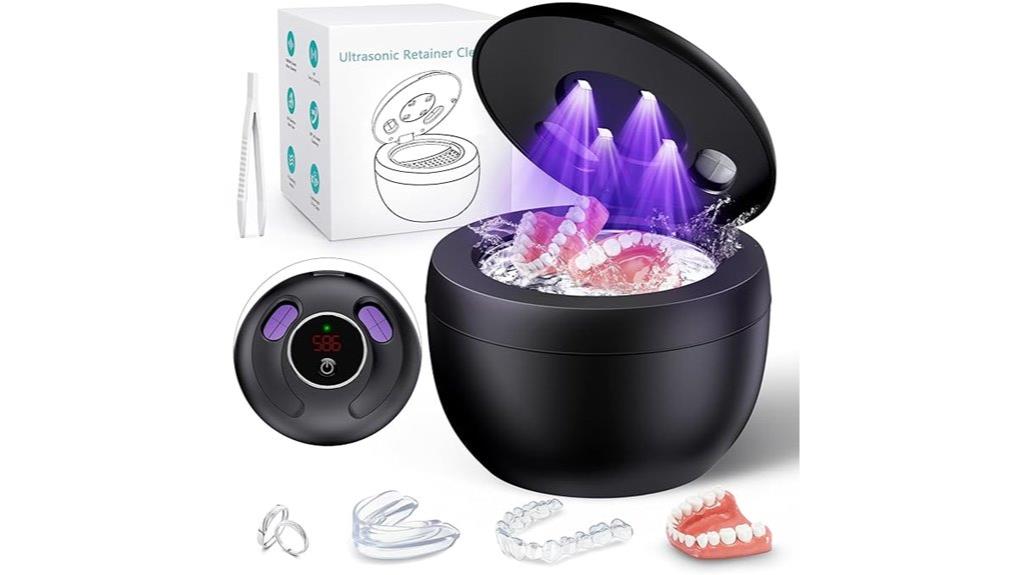
The Upgraded Ultrasonic Retainer Cleaner Machine delivers professional-grade cleaning performance with its 45kHz ultrasonic technology and 200ML capacity, making it the ideal choice for airbrush artists who demand precision cleaning of delicate components. You’ll achieve 99.99% stain removal through millions of micron-scale bubbles that gently clean without damaging sensitive airbrush parts.
Four cleaning modes give you complete control: ultrasonic + UV, deep cleaning, ultrasonic only, and UV only. The four UV lamps provide 360° coverage, eliminating stubborn paint residues three times more effectively than manual brushing. You’ll appreciate the quiet operation under 40Hz and compact design that’s perfect for your workspace or travel kit.
Best For: People with retainers, dentures, aligners, mouth guards, or anyone seeking a convenient and effective way to clean dental appliances and small items like jewelry with professional-grade ultrasonic technology.
Pros:
- Four versatile cleaning modes (ultrasonic + UV, deep cleaning, ultrasonic only, UV only) provide customizable cleaning options for different needs
- Achieves 99.99% stain removal with 45kHz ultrasonic technology and 360° UV cleaning that’s three times more effective than manual brushing
- Compact, portable design with quiet operation under 40Hz makes it convenient for home, office, or travel use
Cons:
- Short power cord length limits placement flexibility near electrical outlets
- Requires cleaning tablets for optimal results, adding ongoing expense
- 200ML capacity may be limiting for cleaning multiple items simultaneously
VisiClean Ultrasonic Jewelry Cleaning Machine
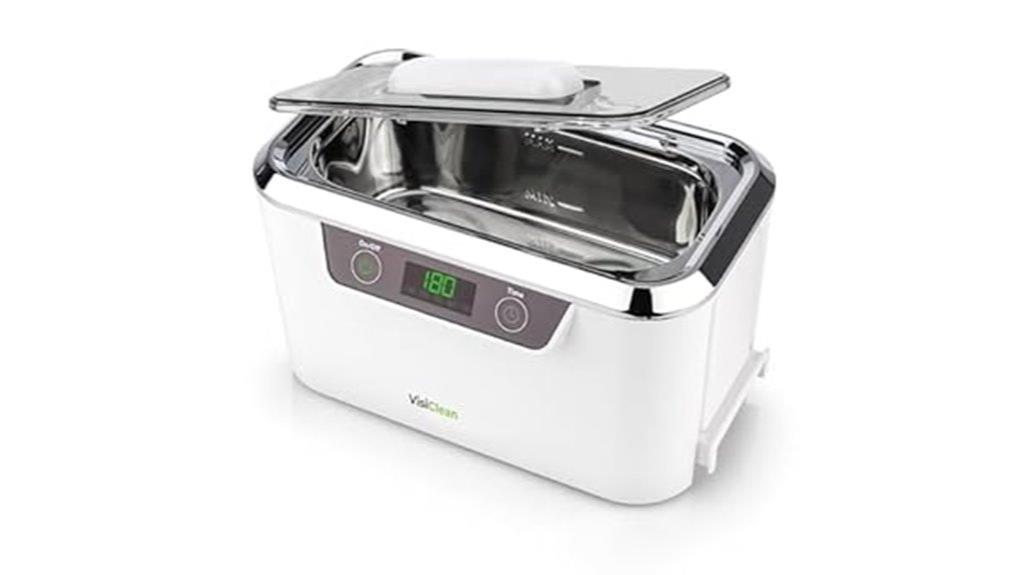
VisiClean’s ultrasonic jewelry cleaning machine delivers dual-unit cleaning power with 65 watts of total consumption, making it an ideal choice for airbrush enthusiasts who need versatile equipment maintenance capabilities beyond traditional single-purpose cleaners. You’ll find this unit handles multiple cleaning tasks effectively, from delicate airbrush components to jewelry and glasses.
The machine offers adjustable time settings for different cleaning requirements. Performance remains consistently strong for most applications, though heavily soiled items may require pre-cleaning. Build quality meets expectations with convenient features like an easy-removal handle and compact design suitable for various equipment sizes.
Operation produces minimal noise during cleaning cycles. However, you should note the 110V power requirement limits international compatibility without transformers.
Best For: Airbrush enthusiasts and multi-purpose users who need versatile cleaning equipment for delicate components, jewelry, glasses, and various personal items.
Pros:
- Dual ultrasonic units provide effective cleaning power at 65 watts for multiple item types
- Adjustable time settings and compact design with convenient features like easy-removal handle
- Quiet operation with minimal noise during cleaning cycles
Cons:
- Performance may degrade over time, especially for heavily soiled items requiring pre-cleaning
- Limited to 110V power requirement, making it incompatible internationally without transformers
- Unit can heat up excessively, making cleaned items difficult to handle immediately after use
LifeBasis Ultrasonic Jewelry Cleaner (600ML) with Digital Timer
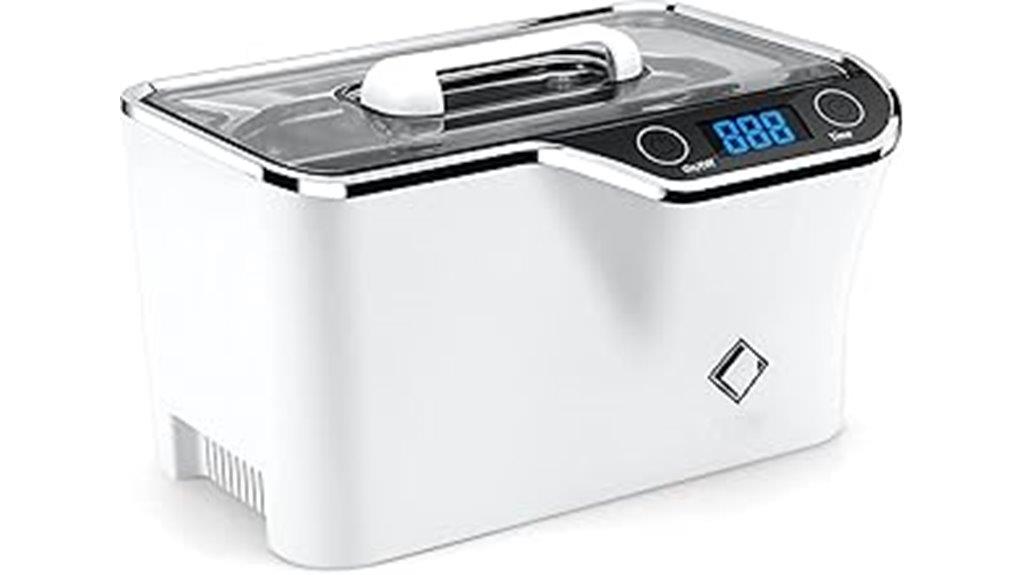
For airbrush enthusiasts seeking professional-grade cleaning performance in a compact package, LifeBasis delivers exceptional value with its 600ML ultrasonic jewelry cleaner featuring sophisticated digital controls.
This unit operates at 42,000-45,000 Hz frequency with 35W transducers, generating powerful cavitation bubbles that penetrate airbrush components thoroughly. You’ll appreciate the five preset cleaning cycles ranging from 90 to 600 seconds, allowing precise timing for different cleaning tasks. The SUS 304 stainless steel tank resists corrosion while remaining compatible with various cleaning solutions.
Measuring 8.03 x 5.51 x 5.12 inches and weighing just 2.16 pounds, it fits easily on your workspace. The built-in cooling fan extends operational lifespan during extended cleaning sessions. With 4.4-star ratings across 4,898 reviews, users consistently praise its effectiveness for delicate equipment cleaning.
Best For: Airbrush enthusiasts, jewelry owners, and hobbyists who need precise, gentle cleaning for delicate items like airbrush components, jewelry, watches, and eyeglasses in a compact home or workshop setting.
Pros:
- Five preset digital timer cycles (90-600 seconds) with powerful 42,000-45,000 Hz frequency provide precise cleaning control for different applications
- Compact 600ML capacity with built-in cooling fan and corrosion-resistant stainless steel tank fits easily on workspaces while ensuring durability
- High customer satisfaction with 4.4-star rating across nearly 5,000 reviews confirming effectiveness for delicate item cleaning
Cons:
- Water-sensitive touch buttons require careful handling during filling and draining to avoid damage
- Limited to light-duty cleaning tasks and not suitable for heavy-duty applications like industrial tool cleaning
- Relatively small 600ML capacity may require multiple cleaning cycles for larger batches of items
Magnasonic Ultrasonic Cleaner – 20oz Stainless Steel Tank
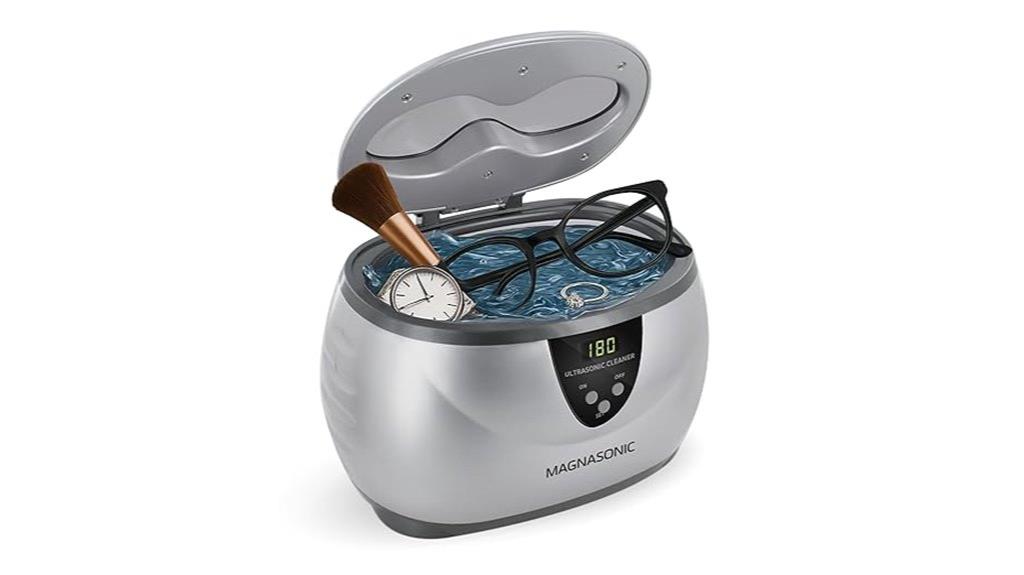
Airbrush enthusiasts seeking a compact yet powerful cleaning solution will find the Magnasonic Ultrasonic Cleaner‘s 20oz stainless steel tank delivers professional-grade results in a desktop-friendly package. The unit operates at 42kHz ultrasonic frequency with five distinct cleaning modes. Digital timer settings range from 90 seconds to 8 minutes (480 seconds), accommodating different contamination levels on airbrush components.
You’ll benefit from its chemical-free cleaning mechanism that removes paint residue, oil buildup, and stubborn deposits through ultrasonic cavitation. The stainless steel construction resists corrosion from cleaning solvents. Users report professional-quality results comparable to commercial cleaning services. For peak performance, combine distilled water with minimal dishwashing detergent.
Best For: Airbrush enthusiasts and hobbyists who need professional-grade cleaning for paint residue and oil buildup on small components without using harsh chemicals.
Pros:
- Five cleaning modes with digital timer (90 seconds to 8 minutes) accommodate different contamination levels
- Chemical-free ultrasonic cleaning at 42kHz effectively removes paint residue and stubborn deposits through cavitation
- Corrosion-resistant stainless steel construction withstands cleaning solvents and delivers professional-quality results
Cons:
- Mixed durability reports with some users experiencing leaks and malfunctions after short periods
- Customer service challenges with reports of non-responses to product issues
- Requires regular maintenance and cleaning after each use to prevent condensation and mold
iSonic Digital Ultrasonic Cleaner (DS300)
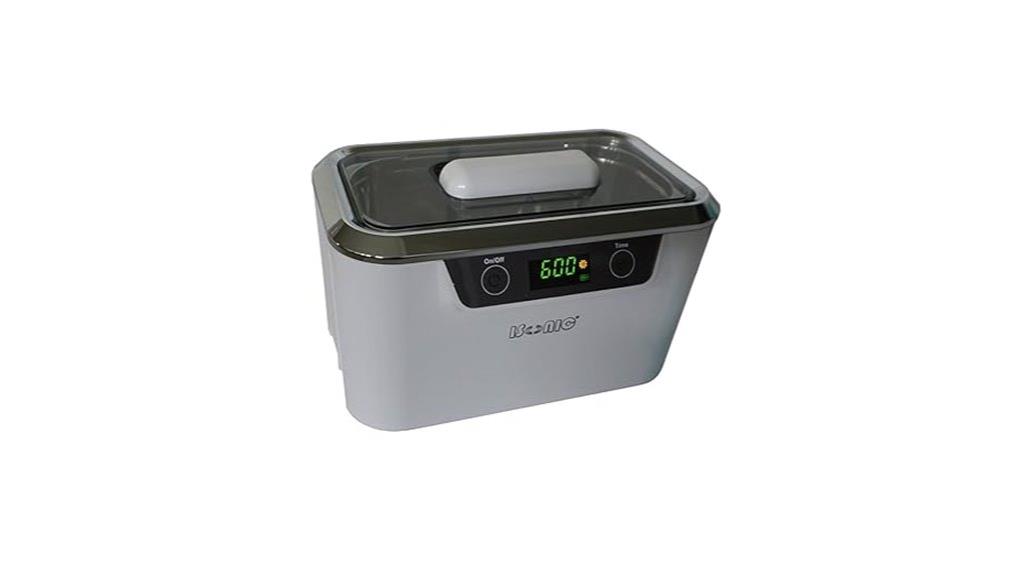
The iSonic DS300 delivers professional-grade ultrasonic cleaning at 42,000 Hz, making it ideal for hobbyists who need precise airbrush maintenance without paying commercial-grade prices. You’ll get dual wafer transducers and touch-sensing controls with a digital timer offering five settings up to 10 minutes maximum.
The 0.8-liter stainless steel tank measures 7.1 x 3.4 x 2.3 inches, providing adequate space for airbrush components, fountain pens, and small cleaning tasks. Its 55W power output with integrated cooling fan guarantees consistent performance during extended cleaning sessions.
However, you should consider reliability concerns. Some users report functionality issues after limited use, and warranty support experiences vary greatly. The DS300 excels at removing acrylic paint from miniatures and hobby tools when paired with appropriate cleaning solutions like Simple Green.
Best For: Hobbyists and craft enthusiasts who need affordable ultrasonic cleaning for airbrushes, miniatures, and small tools, as well as home users wanting to clean jewelry, eyeglasses, and dental retainers.
Pros:
- Professional-grade 42,000 Hz dual transducer system effectively removes acrylic paint and debris from small instruments and hobby tools
- Compact 0.8-liter capacity with digital timer controls makes it convenient for home use and small cleaning tasks
- Versatile cleaning capabilities for multiple items including airbrushes, jewelry, eyeglasses, and dental appliances
Cons:
- Reliability issues reported by users with functionality problems developing after limited use periods
- Inconsistent and potentially poor warranty support from iSonic with some claims being denied
- Limited control options and maximum 10-minute timer may not suit all cleaning needs
Ultrasonic Jewelry Cleaner, 48KHz Cleaner Machine for Jewelry & Eyeglasses
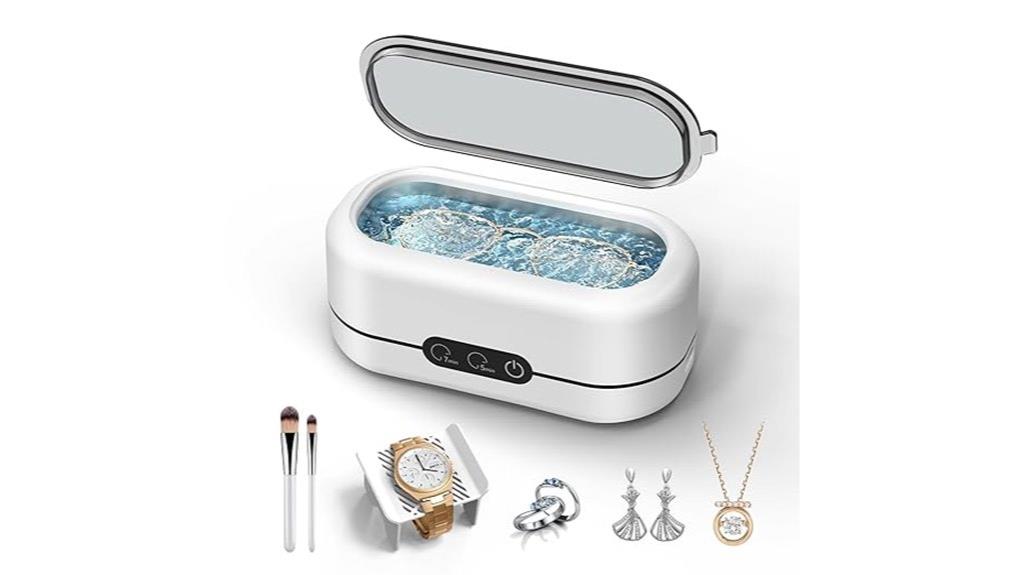
Cleaning precision meets versatility in this 48KHz ultrasonic jewelry cleaner, making it an ideal choice for artists who demand spotless equipment and accessories. You’ll get dual cleaning modes: 5 minutes for regular maintenance and 7 minutes for heavily soiled items. The 12-ounce SUS 304 stainless steel tank resists corrosion while accommodating multiple airbrush components simultaneously.
You can clean with tap water alone, though adding ultrasonic cleaning agents enhances results. The unit operates quietly with non-slip rubber pads preventing movement. You’ll appreciate the compact design for easy storage and the included watch stand for positioning delicate parts. The 48,000Hz frequency effectively removes paint residue and grime without damaging sensitive airbrush components, making this cleaner a cost-effective alternative to professional services.
Best For: Artists and professionals who need to maintain airbrush equipment and delicate accessories with precision cleaning at home.
Pros:
- Dual cleaning modes (5 and 7 minutes) with 48KHz frequency effectively removes paint residue and grime without damaging sensitive components
- 12-ounce stainless steel tank accommodates multiple items simultaneously while resisting corrosion
- Quiet operation with compact design and non-slip pads makes it convenient for studio use and storage
Cons:
- Tank size limitations prevent cleaning of larger objects
- Does not remove tarnish and may require additional cleaning methods for optimal results
- Can experience overheating issues after multiple consecutive cleaning cycles
KUNPHY Ultrasonic Retainer Cleaner for Dental Appliances (White)

Miniature components and delicate airbrush parts demand the precision cleaning that ultrasonic technology delivers, making the KUNPHY Ultrasonic Retainer Cleaner an unexpected champion for detail-oriented artists. Operating at 46 kHz with 18W power output, this compact unit generates thorough 360° cleaning action that reaches intricate nozzle geometries and needle assemblies.
You’ll achieve complete cleaning cycles in five minutes by filling the tank with water and appropriate cleaning solution. The auto-shutoff function prevents overcleaning damage to sensitive components. While designed for dental appliances, its versatility extends to airbrush maintenance with excellent results on metal parts and precision mechanisms. The 30-day money-back guarantee and 12-month warranty provide purchase confidence for professional applications.
Best For: Detail-oriented artists and professionals who need precision cleaning for delicate airbrush components, miniature parts, and other intricate mechanisms that require thorough yet gentle ultrasonic cleaning.
Pros:
- Delivers precise 360° cleaning action at 46 kHz that effectively reaches intricate geometries and sensitive components in just 5 minutes
- Features auto-shutoff function to prevent overcleaning damage and operates quietly during use
- Backed by comprehensive customer support with 30-day money-back guarantee and 12-month warranty
Cons:
- Filling process can be cumbersome due to lack of removable insert design
- Limited and unclear instructions regarding optimal use of included components and cleaning solutions
- May have limitations with certain metals due to potential rust concerns during cleaning process
48Khz Ultrasonic Jewelry Cleaner with UV Lights and Digital Timer
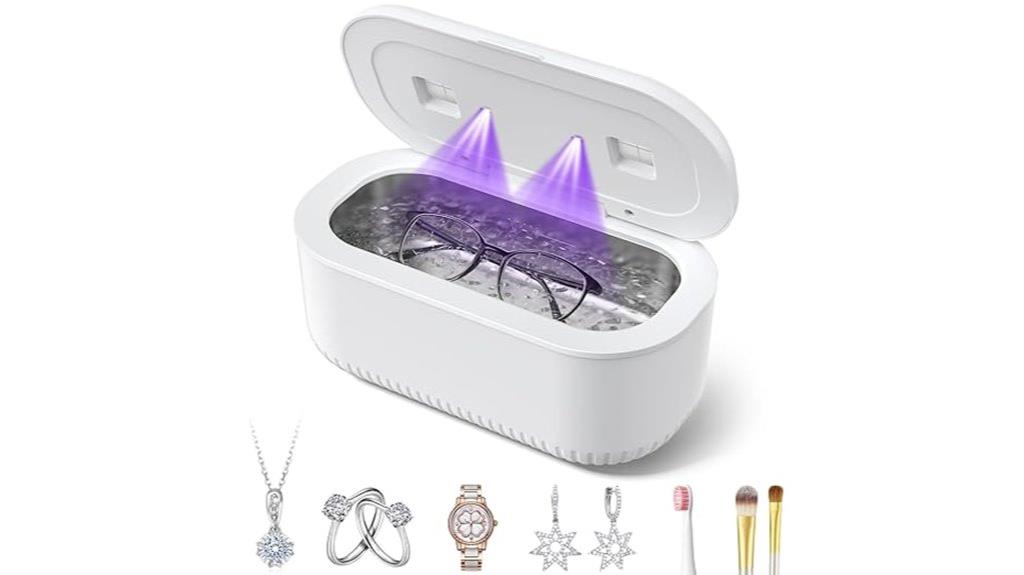
Precision cleaning becomes effortless when you need to maintain delicate airbrush components without risking damage from harsh chemicals or abrasive methods. This 48kHz ultrasonic cleaner delivers 30W power through microscopic cavitation bubbles that penetrate intricate airbrush parts. You’ll get three specialized modes: 180-second regular cleaning, 300-second degassing for oxidation removal, and UV-only sterilization. The 12-ounce capacity accommodates nozzles, needles, and paint cups while operating whisper-quiet at under 35dB. Built-in UV lights enhance sanitization, particularly valuable for preventing paint contamination. The LED timer provides precise control over cleaning cycles. You’ll appreciate the gentle yet thorough action that removes stubborn paint residues without damaging precision components.
Best For: Artists, hobbyists, and professionals who need to maintain delicate airbrush equipment and precision components without using harsh chemicals that could damage sensitive parts.
Pros:
- Three specialized cleaning modes including degassing and UV-only sterilization provide versatile options for different cleaning needs and component types
- Whisper-quiet operation under 35dB with gentle cavitation action effectively removes stubborn paint residues without damaging precision airbrush components
- Built-in UV lights and LED timer offer enhanced sanitization and precise cycle control to prevent paint contamination and ensure optimal cleaning results
Cons:
- 12-ounce capacity may be limiting for cleaning larger airbrush equipment or multiple components simultaneously
- Cold water requirement and potential need for longer cleaning cycles on tougher stains could extend maintenance time
- No mention of specific airbrush cleaning solutions or compatibility, which may require additional research for optimal paint removal results
3L Ultrasonic Cleaner with Heating & Dual-Frequency for Labs, Jewelry & Auto Parts
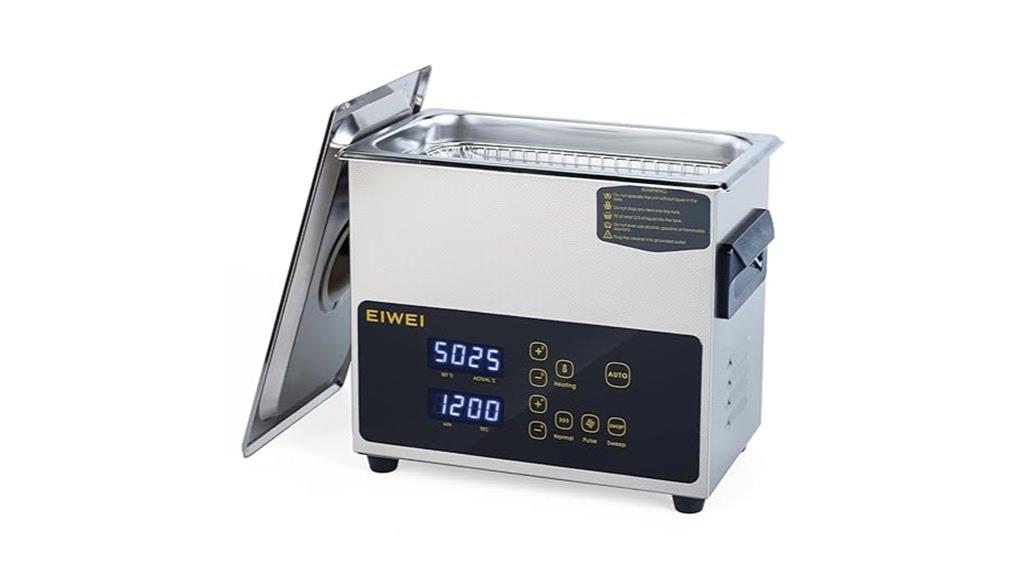
Professional technicians and hobbyists who demand versatile cleaning capabilities will find the 3L Ultrasonic Cleaner with Heating & Dual-Frequency an exceptional choice for airbrush maintenance. This unit operates with 120W transducer power and 100W heating capacity. You’ll access four distinct cleaning modes: Auto for delicate components, Normal for routine maintenance, Pulse for stubborn paint residue, and Sweep mode operating at 28kHz-40kHz frequencies for intricate airbrush internal channels. The SUS304 stainless steel tank provides superior durability over standard SUS201 construction. You can simultaneously clean multiple airbrush components in the 3L capacity tank. Note the operational noise level during use and avoid tap water for maximum cleaning results.
Best For: Professional technicians and hobbyists who need versatile ultrasonic cleaning capabilities for airbrush maintenance, jewelry, lab equipment, and automotive parts.
Pros:
- Four distinct cleaning modes (Auto, Normal, Pulse, and Sweep) with dual-frequency operation for different cleaning needs
- High-quality SUS304 stainless steel construction with 120W transducer and 100W heating power for superior durability
- Large 3L capacity allows simultaneous cleaning of multiple items with intuitive knob controls and adjustable timer
Cons:
- Notable noise level during operation that some users find disruptive
- Cannot use tap water effectively – requires deionized or dedicated ultrasonic cleaning solutions
- Limited to 3L capacity which may not accommodate larger items or bulk cleaning needs
UKOKE 3800S Professional Ultrasonic Jewelry Cleaner Machine (0.6L)
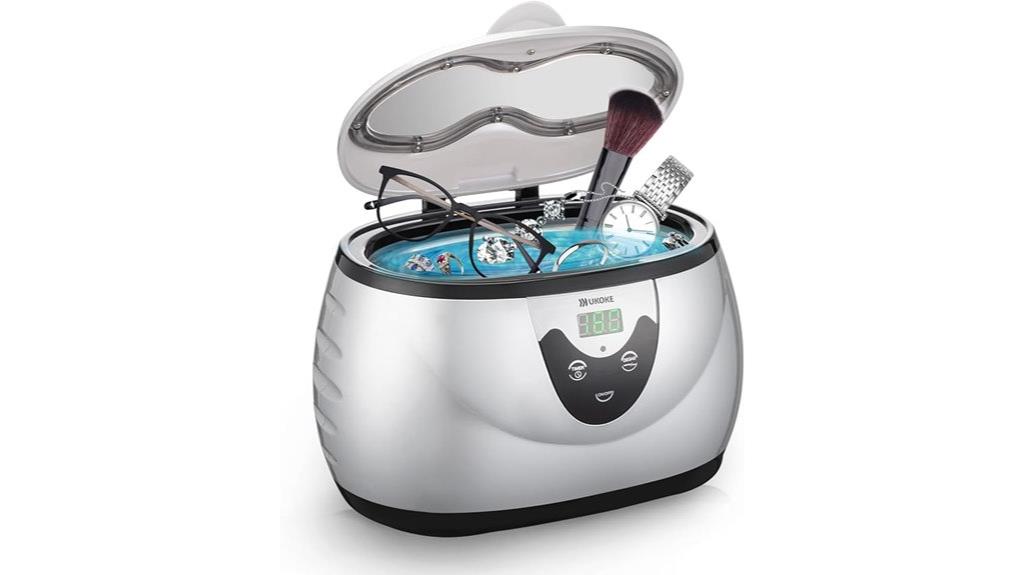
The UKOKE 3800S delivers exceptional cleaning performance for airbrush artists who demand precise maintenance without spending hours on detail work. This 0.6L ultrasonic cleaner generates 42,000 Hz sound waves that penetrate your airbrush’s intricate components. You’ll access five preset cycles ranging from 90 to 480 seconds through the digital touch panel.
The stainless steel tank measures 5.4″ L x 3.6″ W x 2.1″ H, accommodating most airbrush assemblies. The exclusive Degas Mode eliminates air bubbles that reduce cleaning efficiency. You can add liquid dish soap to tap water for enhanced results. With 4.2 out of 5 stars from 10,890 ratings, users consistently report effective cleaning of precision equipment. The compact design fits workshop spaces easily, while silent operation won’t disrupt your workspace.
Best For: Airbrush artists, jewelry makers, and professionals who need precise ultrasonic cleaning for delicate equipment and intricate items in workshop or studio environments.
Pros:
- Five preset cleaning cycles (90-480 seconds) with digital touch controls provide versatility for different cleaning needs
- 42,000 Hz ultrasonic waves with exclusive Degas Mode deliver deep, gentle cleaning that reaches intricate components
- Silent operation and compact design make it suitable for workspace use without disruption
Cons:
- Some users report durability issues and reduced product lifespan with regular use
- Cleaning effectiveness may vary depending on the type of items being cleaned
- Not suitable for delicate materials like pearls, coral, emeralds, and jade
Factors to Consider When Choosing an Ultrasonic Cleaner for Airbrush
When I’m selecting an ultrasonic cleaner for airbrush maintenance, I consider five critical specifications that directly impact cleaning performance and operational efficiency. Tank size capacity determines how many airbrush components you can clean simultaneously, while ultrasonic frequency range affects the intensity and precision of particle removal from delicate parts. The combination of timer settings, temperature control features, and power output specifications guarantees you’ll achieve consistent results without damaging sensitive airbrush mechanisms.
Tank Size Capacity
Since airbrush components vary considerably in length and diameter, selecting the appropriate tank capacity becomes essential for effective ultrasonic cleaning. I recommend a minimum 0.6-liter capacity for standard airbrush maintenance. This volume provides adequate depth for complete submersion of most airbrush bodies and components.
For users cleaning multiple airbrushes simultaneously, I suggest upgrading to a 3-liter tank. This larger capacity accommodates batch cleaning operations and handles oversized components like spray guns or compressor parts. The tank’s internal dimensions matter more than total volume—ensure sufficient length and width clearance for your specific equipment.
Stainless steel construction proves essential for durability and chemical resistance. Compact designs offer practical storage solutions while maintaining necessary cleaning depth for thorough ultrasonic action.
Ultrasonic Frequency Range
Frequency selection determines the cleaning intensity and precision your ultrasonic cleaner delivers to airbrush components. Most airbrush-specific units operate between 40-45 kHz, generating microscopic cavitation bubbles that penetrate tight crevices without damaging delicate parts. I recommend 42 kHz as the ideal balance between thorough cleaning and component protection.
Higher frequencies like 48 kHz provide gentler action for sensitive nozzles and needles. Lower frequencies below 40 kHz create larger bubbles with stronger agitation, but they’ll risk damaging fine equipment. Think of frequency like sandpaper grit—higher numbers mean finer action.
Adjustable frequency settings give you maximum versatility. You can use gentle 48 kHz for precision components and stronger 40 kHz for heavily soiled parts. This flexibility guarantees you’re matching cleaning intensity to your specific maintenance needs.
Timer Settings Options
Beyond frequency selection, timer settings control how long your airbrush components undergo ultrasonic treatment. Most cleaners offer ranges from 90 seconds to 10 minutes. I recommend models with multiple preset options for flexibility. Quick 90-second cycles handle light paint residue, while 5-10 minute cycles tackle dried acrylics or stubborn pigments.
Digital displays provide clear countdown visibility and automatic shutoff. This prevents over-cleaning that can damage delicate needle tips or seals. Variable timing is essential for different materials—metal components tolerate longer cycles than rubber O-rings.
Advanced models include degas and UV modes alongside standard timers. Degas removes trapped air bubbles for enhanced cleaning efficiency. Select cleaners with at least three timer presets to match your specific airbrush maintenance needs.
Temperature Control Features
While timer settings control duration, temperature control features determine the thermal conditions that enhance cleaning effectiveness for your airbrush components. Higher temperatures increase cavitation activity, creating more aggressive bubble collapse that removes stubborn paint residues and oils. I recommend models with built-in heating systems that reach 140-160°F for ideal performance.
Digital temperature displays provide precise monitoring during cleaning cycles. You’ll see real-time readings that guarantee consistent thermal conditions throughout the process. Most quality units offer preset temperature settings specifically designed for delicate equipment cleaning.
Warm water dissolves paint particles more effectively than cold solutions. However, avoid boiling temperatures that could damage sensitive airbrush seals and gaskets. Temperature-controlled cleaning reduces processing time while delivering superior contamination removal from needle assemblies, nozzles, and internal passages.
Power Output Specifications
Temperature settings work alongside power output specifications to determine your ultrasonic cleaner‘s overall performance capabilities. I recommend units operating between 35 to 100 watts for airbrush cleaning. Higher wattage creates stronger cavitation bubbles that dissolve stubborn paint residue more effectively.
Frequency matters equally with power output. Lower frequencies around 35 kHz provide aggressive cleaning for heavy buildup, while higher frequencies near 70 kHz offer gentler treatment for delicate airbrush components. I prefer dual-frequency models that let you switch between settings based on cleaning requirements.
Power output directly affects cleaning intensity. A 60-watt unit removes acrylic paint faster than a 35-watt model, but excessive power can damage sensitive needle assemblies. Match your power selection to your specific cleaning needs and airbrush materials for best results.
Cleaning Solution Compatibility
Three fundamental solution types determine cleaning effectiveness in ultrasonic airbrush maintenance: distilled water, specialized ultrasonic formulations, and paint-specific solvents. I recommend verifying compatibility before selecting your cleaner, as certain devices restrict solvent types to prevent component degradation.
Distilled water provides the safest baseline option for most ultrasonic units. It eliminates mineral deposits that could damage transducers while maintaining peak cavitation efficiency. Specialized ultrasonic cleaning agents enhance this performance by reducing surface tension and improving debris suspension.
Avoid harsh alcohol-based solvents unless your manufacturer explicitly approves them. These chemicals create safety hazards and potentially void warranties through internal component damage.
Degassing features considerably improve solution effectiveness by eliminating trapped air bubbles that interfere with cavitation. Always consult manufacturer guidelines for approved formulations to guarantee peak cleaning results and equipment longevity.
Build Quality Materials
Superior construction materials determine your ultrasonic cleaner’s operational lifespan and cleaning consistency. I recommend units featuring SUS 304 stainless steel tanks. This grade offers superior corrosion resistance compared to lower-grade alternatives and won’t degrade when exposed to cleaning solvents.
Look for reinforced seam construction. Well-welded joints prevent leaks during extended operation cycles. The tank should feel substantial and exhibit no flex when filled.
Built-in cooling fans prevent thermal damage during prolonged cleaning sessions. Overheating reduces component lifespan and compromises cleaning effectiveness. Choose models with transparent lids for process monitoring without opening the unit.
Verify consistent wattage ratings. Higher wattage typically delivers more effective cleaning power. I’ve found that reliable power sources maintain stable ultrasonic frequency output, ensuring consistent results across multiple cleaning cycles.
Portability and Storage
Beyond construction quality, workspace constraints greatly impact your ultrasonic cleaner selection. I recommend evaluating size and weight specifications first. Compact models measuring 8x6x4 inches typically weigh 2-3 pounds, making them ideal for cramped workbenches or frequent transport between stations.
Tank capacity directly affects portability. A 600ml tank accommodates multiple airbrush components simultaneously but increases overall dimensions. Smaller 400ml units sacrifice capacity for enhanced mobility. You’ll want lightweight aluminum or high-grade plastic construction rather than steel housings that add unnecessary weight.
Storage features enhance usability substantially. Detachable power cords prevent tangling during transport. Some models feature stackable designs that maximize vertical storage efficiency. Consider units with integrated cord wraps or accessory compartments. These features transform a basic cleaner into a portable workstation that fits seamlessly into your existing workflow and storage system.
On a final note
I’ve reviewed eight top-performing ultrasonic cleaners that’ll transform your airbrush maintenance routine. Each model offers distinct advantages—from the compact 200ML unit for basic cleaning to the 3L dual-frequency system for heavy-duty applications. Consider your cleaning volume, frequency requirements, and budget when selecting. These units eliminate manual scrubbing while reaching internal passages you can’t access otherwise. Your airbrush performance depends on consistent cleaning, and ultrasonic technology delivers that reliability.





